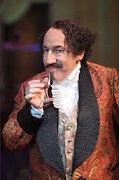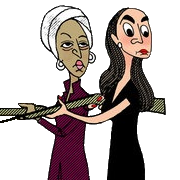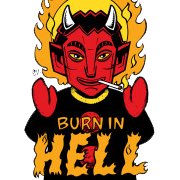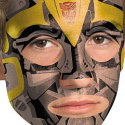|
Another framing issue: https://www.youtube.com/watch?v=j0USsZhzJI8 I've noticed an oddity with a few 1970s Shaw Brothers Studio / Hong Kong Kung Fu films. They were clearly in 2.35:1 (both on DVD and on that El Rey cable channel) but it seemed like at certain brief moments the picture was kind of compressed at the sides so that the far edges were thinned. Almost like a 2.7:1 film was accordioned to 2.35:1 Anyone know what that issue is?
|
|
|
|

|
| # ? May 8, 2024 03:11 |
|
Zogo posted:Another framing issue: A lot of Asian studios ended up buying the first and second generation CinemaScope lenses from Fox, which still had distortion problems. You'll notice squashing on earlier CS films like Rebel Without a Cause and 20,000 Leagues Under the Sea. The later lenses fixed this problem by evening out the amount of squeeze across the entire image. So, a lot of the lenses used for "ShawScope" or "TohoScope" are really early lenses. They just got them cheap compared to the newer ones that would cost 20x more. On that note, a lot of scope films are shot full aperture, but framed to accommodate for the optical track on the side. Sometimes, video transfers were made without the operators knowing this. That's why the first DVD of The Great Escape was ridiculously wide and off-center.
|
|
|
|
Egbert Souse posted:A lot of Asian studios ended up buying the first and second generation CinemaScope lenses from Fox, which still had distortion problems. You'll notice squashing on earlier CS films like Rebel Without a Cause and 20,000 Leagues Under the Sea. The later lenses fixed this problem by evening out the amount of squeeze across the entire image. So, a lot of the lenses used for "ShawScope" or "TohoScope" are really early lenses. They just got them cheap compared to the newer ones that would cost 20x more. That's interesting. It's surprising to me that they sold those things knowing that they were essentially defective to some degree. But I guess if you can get something that looks decent for the most part at 1/20th of the cost it makes sense in many situations.
|
|
|
|
Zogo posted:That's interesting. It's surprising to me that they sold those things knowing that they were essentially defective to some degree. But I guess if you can get something that looks decent for the most part at 1/20th of the cost it makes sense in many situations. They were just not refined as much. I don't think they were selling the very first lenses, which actually used prisms created in the 1920s, but the later ones built by Bauch & Lomb. But yeah, that's why you see American International using CinemaScope on most of the Corman/Poe/Vincent Price films of the 1960s. They were using the old lenses. It's really obvious on The Masque of Red Death (shot by Nicolas Roeg). Older lenses are coming back in popularity, though. There Will Be Blood was partially shot with some 1910s prime lenses, the "Happy" music video was shot with a 1970s Panavision anamorphic lens fixed to an Arri Alexa, and of course, Ultra Panavision being resurrected for The Hateful Eight.
|
|
|
|
Egbert Souse posted:but the later ones built by Bauch & Lomb. Wait, the contact lens company built lenses for film cameras?
|
|
|
|
Timby posted:Wait, the contact lens company built lenses for film cameras? The same. They were a leader of optics for almost a century before going into contacts. They partnered with Zeiss and made lenses for projectors, microscopes, and cameras before CinemaScope was invented.
|
|
|
|
They were showing a 1916 silent movie on TCM today and I was wondering (this may belong in Emulsional Rescue)- why do a lot of these films, or at least scenes in them, have kind of a circular framing, where you can kinda see the corners but it's darker than the rest of the image? Is that anything to do with how they were shot or is it more a degradation issue?
|
|
|
|
I could be wrong about this but from what I understand this was more of a framing thing. There are many silent pictures which use unconventional framing within the traditional framing. One example off the top of my head is Lang using strips of black on both the right and left to create a more vertical image, a sort of vertical letter boxing if you will.
|
|
|
|
Maxwell Lord posted:They were showing a 1916 silent movie on TCM today and I was wondering (this may belong in Emulsional Rescue)- why do a lot of these films, or at least scenes in them, have kind of a circular framing, where you can kinda see the corners but it's darker than the rest of the image? Is that anything to do with how they were shot or is it more a degradation issue? Two reasons: Silent film, especially by the mid-teens, often used mattes or apertures. The old iris-in/iris-out device, for example (you can see in the opening shot of The Gold Rush) and Abel Gance loved using a partially closed iris to soften the edges. If you ever see Napoleon, it's full of lovely shots like this. Even some where an ivory iris was used, which caused the border to be white instead of black. I'm going to guess that the 1916 film is Intolerance? Griffith was a master at using mattes to drive focus to parts of the screen. Also, most silent films have gone through more than usual copying, which can cause vignetting and video transfers have often been made more open than they would have been played theatrically. The very first US DVDs of Charlie Chaplin's (estate-owned) films were transferred so that you could actually see sprocket holes on the side. But they were transfers created when overscan would have completely hidden this. More reason why anything for Blu-Ray should absolutely be exact rather than too open or too cropped. It's now possible to display a precision aspect ratio and framing, more than what would be possible in even the best theaters.
|
|
|
|
I like vignetting personally, for photography at least. It's a nice method to push the eyes towards the part of the frame that you want the viewer to look at. Funny how a byproduct of a flaw in lenses can become a pleasing aesthetic.
|
|
|
|
Egbert Souse posted:Two reasons: No, it was "The Good Bad Man" with Douglas Fairbanks but it was actually made by Griffith's company while he was making Intolerance so there may have been some bleedover in techniques.
|
|
|
|
I did not know that different aspect ratios meant cropping. I had thought it was "stretching". Thank you for the thread.
|
|
|
|
Benny Hill did a skit back in 1969 parodying pan & scan: http://www.dailymotion.com/video/x153jaw_the-benny-hill-show-1969-tv-pan-and-scan-demonstration_fun
|
|
|
|
Egbert Souse posted:Benny Hill did a skit back in 1969 parodying pan & scan: That's pretty good in getting the point across and actually putting it in a way that people could grasp without being technical at all. And it was nearly fifty years ago.
|
|
|
|
Masters of Cinema, the Criterion of the UK, released their Blu-Ray of Shane. What's special about it? Three presentations. If you've read up on the history of George Stevens' film, you'd know it had a long production and long post-production. It took so long that by the time it was ready for release, the industry was in the process of switching to widescreen. While the film itself was shot for normal 1.37:1 (production started in 1951), it was presented in theaters at 1.66:1. In fact, the opening and closing titles were designed to work with the 1.66:1 cropping, which makes them appear more open when seen at 1.37:1.  Masters of Cinema opted to include Paramount's 4K restoration, from the 3-strip Technicolor negatives, three ways. The first being 1.37:1 pillarboxed, which is how the film was originally shot. The only thing off is obviously the titles since they were designed for 1.66:1. They also included two presentations at 1.66:1. One replicating the center crop that theaters would have shown in 1953. Another is a special 1.66:1 version that George Stevens, Jr. supervised, which is reframed when the center crop looked a little tight. Not the entire film is reframed, but specifically shots that could use some tilting up or down. Speaking of the titles, it's worth noting that for normal 35mm films meant for widescreen, the opening titles would be designed to be a framing guide. This was extremely helpful for the few 35mm films that were not shot for widescreen, but could be shown in widescreen with adjustments. You'll notice that the main title to The Big Heat looks unusually off-center. It was designed so that projectionists would move the picture upwards to allow for generally pleasing framing. This was standard procedure on the bubble of films shot right before or during the transition from 1.37:1 to widescreen. Here's a few other examples of off-center titles as a guide for optimal framing of non-widescreen movies for widescreen projection:    It's also worth noting that this was occasionally done for re-issues of films. Gone with the Wind was released in 70mm in 1967, which cropped the film from 1.37:1 to 2.20:1. You'll probably wonder how they got around the titles since they, like all other films of the time, were designed exclusively for 1.37:1 projection. Easy solution. MGM opted to just exclude the entire opening titles sequence in favor of rephotographing all the text, including the sweeping main title, as static text on static backgrounds. It probably looked somewhat like this underwhelming title from the 1950s trailer: 
|
|
|
|
Streaming services and TV networks still crop movies, but now they crop from 2.35:1 to 16:9. I guess someone still thinks people won't watch with those black bars. The ridiculous thing is that millions of people still have 4:3 TVs so they'll see black bars no matter what.Corek posted:Weirdly a lot fewer people have problems with old TV shows like Seinfeld being cropped to fill widescreen TVs Old TV shows are often just stretched to 16:9. Once I saw part of a movie that had been cropped to 4:3 and then stretched to 16:9.
|
|
|
|
Action Jacktion posted:Streaming services and TV networks still crop movies, but now they crop from 2.35:1 to 16:9. I guess someone still thinks people won't watch with those black bars. The ridiculous thing is that millions of people still have 4:3 TVs so they'll see black bars no matter what. At least if they stretch 4:3 to 16:9 you can make your tv fix it, the really terrible ones are the ones that crop a 4:3 to make it 16:9 so you lose picture and screw everything up (the tv version of what Egbert Souse just posted).
|
|
|
|
Action Jacktion posted:Streaming services and TV networks still crop movies, but now they crop from 2.35:1 to 16:9. I guess someone still thinks people won't watch with those black bars. The ridiculous thing is that millions of people still have 4:3 TVs so they'll see black bars no matter what. Netflix and other streaming services don't do the cropping, they're just at the mercy at whatever file they get handed by the studios. Whoops, we used a 16 by 9 TV master? Didn't realize it. Sometimes, it gets fixed. Other times... What's funny was I was recently in the hospital, and usa was airing the Indiana Jones films. Temple of Doom was in 2.35:1, but the Crystal Skulls was cropped to 16:9.
|
|
|
|
The Seinfeld widescreen releases just opens up a whole lot of wasted space on the sides because everything was framed with 4:3 in mind. Whole lotta close talking. I get why they did it, but it is pretty silly.
|
|
|
|
MrBling posted:The Seinfeld widescreen releases just opens up a whole lot of wasted space on the sides because everything was framed with 4:3 in mind. The reframing job is pretty decent, considering what they had to work with. Nothing much gets chopped off. Though, I did spot one scene in a car where they forgot to composite in the background, showing only the blue screen.
|
|
|
|
Seinfeld doesn't open us massively, as it wasn't shot on a 16:9 friendly negative. I've seen some jokes get cropped out when I saw it on TBS broadcasts, which irked me a bit. The framing just isn't as nice in 16:9 too. Friends was better as it was shot on a negative that's so close to 16:9 that you don't lose anything at all, but you do get a few dodgy things in frame now. e: you'll also notice when they blow focus more often, now it's not disguised by crappy old NTSC SD.
|
|
|
|
With the release of The Hateful Eight in a few days, why not go over roadshow presentations? Roadshows were not something invented for the widescreen era, but actually from much earlier. The Birth of a Nation was one of the first presentations. It was shown in limited release with reserved seats, no different from a going to see something on stage. D.W. Griffith made it even more special by hiring a composer (Joseph Carl Breil) to create a full orchestral score for the film. Tickets were also more expensive partially to cover the then-astronomical cost to produce the film, but to give it more legitimacy. In later years, souvenier programs were handed out (or for sale) only at these presentations. You can see more on silents and 1930s-1940s roadshows here. There were other special presentations. One of the highest grossing films of 1952, This is Cinerama, was open in only one theater for that entire year and before it moved to other theaters. Fantasia had a brief roadshow in 1940, which featured the 8-track Fantasound stereo-surround presentation. The Jazz Singer even had an overture and exit music, but no intermission due to the moderate runtime. On home video, you'll notice that more times than not, the special "music" segments have text cards informing of the overture, intermission, entr'acte, and exit music. With very few exceptions, these sections were literally just black leader with just sound on the actual prints. A few films are appropriately played without stuff added on Blu-Ray and DVD like Lawrence of Arabia, 2001, and Patton.  The overture wasn't meant to be the start of the film exactly (with exceptions), but served the same purpose as the overture to an orchestral piece or stage production. In a theater, the curtain would be closed and the lights would be dimmed slightly. It was basically a way to get everyone in the theater and be ready for the start of the film. A few films broke tradition by having images during the overture. Most notable would be West Side Story and My Fair Lady, which have filmed graphics. The Ten Commandments has a brief intro by director Cecil B. DeMille after the overture, but prior to the film proper. Surviving documents with directions on running these presentations indicated that the curtain would be opened as soon as the logo turned up or the first bit of credits. That's partially why the opening logos on films like Ben-Hur and 2001: A Space Odyssey linger a bit. They wanted the projectionist to have enough time to open the curtains. Not all roadshow movies had all these functions. Around the World in 80 Days doesn't have an overture, Ben-Hur doesn't have exit music, and Gone with the Wind didn't have an on-screen intermission title. Seven Samurai has an intermission, but no overture or exit music. Fantasia and Apocalypse Now don't have any on-screen credits in their roadshow versions, but rather had printed programs given out. Fantasia didn't even have opening or closing credits, but rather had the title shown exclusively during a slide projected during the intermission (replicated on the DVD and Blu-Ray). The intermission was not meant to be dead center of the film, but rather at a good break to divide the first and second acts. Most films actually had a text card that said "Intermission" - the Blu-Rays for Doctor Zhivago, Ben-Hur, Lawrence of Arabia, and 2001: A Space Odyssey all have the original graphic. It's also worth noting that many 1950s 3-D films had a brief intermission out of necessity to projects to be re-loaded (such as Dial M for Murder and House of Wax). Most intermissions were 15 minutes. Usually, they would simply stop the projector. In one rare case, It's a Mad, Mad, Mad, Mad World had a special full reel that featured police calls meant to be piped into the lobby (and bathrooms!) that actually referenced the first act of the film. Criterion's Blu-Ray has a reconstruction of the roadshow cut with this feature intact. It's also worth noting that the curtain would be closed on the intermission graphic, if present. The entr'acte served the same purpose as the overture, except to get people back into the theater. The curtain would be closed and would open as the image began on the screen. Some films have longer shots to accommodate this. You'll notice that the first shots after the entr'acte in Lawrence of Arabia and Ben-Hur are a bit longer than normal. As most roadshow-era films had all the credits at the beginning, the exit music would play over a closed curtain, usually after it closed after "THE END" the last bit of credits. Note how the ending shots of 2001 and Doctor Zhivago keep the "THE END" or "RELEASED BY___" cards on-screen longer than usual. Technically, roadshow films usually had the best of technology. Gone with the Wind was shot in Technicolor and was the first film to use a new improved dye-transfer process. The 1950s and 1960s roadshow films were often shot in large format systems and with stereo sound mixes. Lawrence of Arabia was shot in Super Panavision and shown almost exclusively in 70mm until its general release. In fact, by the time the general release came out, the film was edited down. For a later release, it was edited further and lost its music-only segments. There were also many films shot on regular 35mm like Doctor Zhivago (Panavision) that received the full roadshow treatment in 70mm. You can actually read surviving exhibitor guides to presentations on Widescreen Museum: http://widescreenmuseum.com/widescreen/showmanship.htm They have sheets for Gone with the Wind, Ben-Hur, The Ten Commandments, El Cid, West Side Story, and It's A Mad Mad Mad Mad World. Egbert Souse fucked around with this message at 17:57 on Dec 20, 2015 |
|
|
|
Egbert Souse posted:In one rare case, It's a Mad, Mad, Mad, Mad World had a special full reel that featured police calls meant to be piped into the lobby (and bathrooms!) that actually referenced the first act of the film. That would've been a funny experience. That's one I need to watch now that it's available in a much better format compared to VHS.
|
|
|
|
Zogo posted:That would've been a funny experience. That's one I need to watch now that it's available in a much better format compared to VHS. Be warned that the roadshow cut exists incomplete and all exclusive footage survives as faded and damaged 70mm and or a non-anamorphic laserdisc transfer. It looks surprsingly good despite that, but expect something patchwork like Metropolis. The general release cut, though survives intact and was scanned in 8K resolution from the camera negative and restored at 4K. Easily one of the best 70mm presentations on Blu-Ray.
|
|
|
|
I have a dumb technical question that isn't really related to aspect ratios but I figured someone here might know. I've seen some things* lately that are from old film prints that are in less than great shape, and often there will be big green lines running down the picture for awhile. Is this like something to do with the digital transfer, like does it mean there was a big empty spot in the film that was physically torn out and the green is the "background" behind the film poking through or what? *mostly educational short film VODs from Rifftrax
|
|
|
|
The next Light Gun Man posted:I have a dumb technical question that isn't really related to aspect ratios but I figured someone here might know. Green lines are from emulsion scratches. Sometimes the green hue is from the video transfer being manipulated to enhance faded color.
|
|
|
|
Neat, thanks.
|
|
|
|
Action Jacktion posted:Streaming services and TV networks still crop movies, but now they crop from 2.35:1 to 16:9. I guess someone still thinks people won't watch with those black bars. The ridiculous thing is that millions of people still have 4:3 TVs so they'll see black bars no matter what. I wonder if this is similar to why sport networks sometimes screw up their ratio and you can't see half of the score graphic since it's cut off by the edge of the screen. One month it's fine, another month it's cut off.
|
|
|
|
The Oscar telecast has hosed this up on occasion too. Though I only noticed when I still had a standard def TV.
|
|
|
|
effectual posted:I wonder if this is similar to why sport networks sometimes screw up their ratio and you can't see half of the score graphic since it's cut off by the edge of the screen. One month it's fine, another month it's cut off. What's been doing that recently? I haven't seen network errors like that in many years. Usually it means the TV or cable box is misconfigured.
|
|
|
|
I work at a post house and when we deliver features, we almost always make a 2:35, a 1:78 and a 1:33 cut. I die inside whenever they ask me to do it.
|
|
|
|
Where do the 1.33 versions turn up? On VCDs in Asia?
|
|
|
|
ruddiger posted:I work at a post house and when we deliver features, we almost always make a 2:35, a 1:78 and a 1:33 cut. I die inside whenever they ask me to do it. This is pretty odd. I'd also be interested in what the other versions are for, especially the 1:33 cut on most things.
|
|
|
|
Escobarbarian posted:This is pretty odd. I'd also be interested in what the other versions are for, especially the 1:33 cut on most things. Crappy plane versions? But then surely they'd be edited for content as well. Does this mean someone is still employed doing pan and scan?
|
|
|
|
I worked on 50 Shades of Grey, and we had to do separate versions of all the text message popups repositioned for 1.33 framing, but I can't imagine that would be a movie they'd show on airplanes.
|
|
|
|
Sounds annoying, I imagine there's a 50/50 chance they'd never use the 1.33 version but make it as a deliverable "just in case." I still get annoyed when we have to position titles in mock news lower 3rds or bugs to be 4:3 safe. In TYOOL 2016 we're still dealing with SD 4:3 TV's and catering to them with titles and graphics. On the other hand we're never really concerned with content being 4:3 safe so I guess shows just don't want to look like they cut off text but are fine with it looking like it was framed by a blind Operator.
|
|
|
|
The 1:33 cuts are almost always for international versions. The 16:9 are usually for streaming sites. We mostly do tv shows or commercial spots, but making deliverables for commercials, I'll tell you half the time we have to make these alternate aspect ratio files is because the producer of the show/spot has no loving idea what they're doing. I once got an HDCam in and was told to digitize it and re-export for file delivery. Cool, what format, frame rate, etc? I get an email with just one word. Anamorphic. After multiple back and forths, they finally told me they needed an NTSC 4x3 Anamorphic Pro Res file. Which is fine, but who loving writes "anamorphic" expecting anyone to know what the gently caress that means? They might as well have written "Quicktime" or "Computer file." Producers are the loving worst, followed by upjumped Assistant Editors who can't online a show to save their loving life. (COMMIT GROUP EDITS MOTHERFUCKER, DO YOU KNOW HOW?)
|
|
|
|
For the 1.33:1 stuff, what's the resolution? Is it standard def, or are you doing HD transfers cropped to 1.33:1?
|
|
|
|
ruddiger posted:I work at a post house and when we deliver features, we almost always make a 2:35, a 1:78 and a 1:33 cut. I die inside whenever they ask me to do it. The longer this goes on with Cable TV the more perplexing it's becoming. Even if people want to see a 1.33 film or 2.35 film in 16x9 they can use zoom on their TV settings or cable box. The same goes for bluray/DVD players. That's why I love MGMHD and TCMHD. The only two channels that nearly always have films framed properly. Yes, even 1.85 films are shown properly so 100% of the picture is seen. Whereas, most channels will convert 1.85 to 16x9 and lose ~4% of the picture. Taking old 4:3 news footage and turning it to 16x9 frequently looks odd as well. ruddiger posted:I get an email with just one word. Anamorphic. 
|
|
|
|

|
| # ? May 8, 2024 03:11 |
|
Does anyone in the first world, under the age of 70, still own a 4:3 TV? I'm pretty sure those left stores around 2009 and even than they had been on the way out for a few years.
|
|
|































